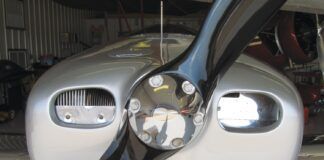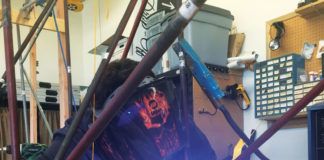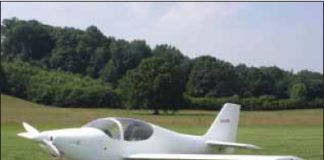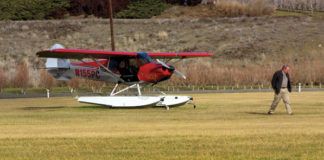Editors Note: Were breaking our own rules here. The author has become, since starting this journey, the Canadian distributor for the A-24. It is not our policy to allow companies or their representatives to write about their own product. But there’s an interesting story here of an intriguing airplane. We intend for one of our test pilots to fly the A-24 and write about it soon.
Like most pilots,
I love fast airplanes, which accounts for my love affair with the Questair Venture. But speed isn’t the only thing that makes flight enchanting. A decade ago, a good friend invited me to ride shotgun in his float-equipped aircraft for a trip to his cottage. I jumped at the opportunity, resulting in another hook being set.Shortly thereafter, I commenced research on amphibious aircraft and months later ordered a SeaRey kit. The SeaRey is manufactured by Progressive Aerodyne, a well regarded, Florida-based company. Then as now, Progressive enjoyed an excellent reputation for turning out kits that were easily converted into dependable aircraft that perform well both in the air and on the water. There are hundreds of SeaRey amphibians operating around the continent, and most owners love them. When my kit arrived, I set to work with enthusiasm.
As is so often the case, a career and a growing family reduced available build time, and progress on the SeaRey proved intermittent. Further restricting my efforts was the fact that I began to make good progress toward solving my Ventures problems. It became obvious that the Venture would see flight before the amphibian, so I sold my partially completed SeaRey kit.
Not Out of the Water Yet
Fast forward to 2004. Once again, a flight in an amphibian reignited the embers, and a good friend forwarded pictures of a mysterious, tractor-configured amphibian. “What aircraft is this?” he asked. “No idea,” I replied, “but it sure looks interesting, so lets see if we can track it down.”
Weeks later, a search through foreign language aviation web sites unearthed a reference to our mystery ship, the A-24, manufactured by Aeroprakt, a small aerospace company located in Ukraine. Ukraine? I asked my circle of aviation experts, but could find none who knew of Aeroprakt.
The first contact with Aeroprakt unearthed both good news and bad. The good news was that Aeroprakt had been established by talented design engineers, formerly employed by Antonov. The really good news: The A-24 had been designed and was constructed in exactly the same manner as are all Antonov products, that is, to military standards. The bad news was that none existed in North America, nor had the aircraft been licensed in North America. Intensive research commenced.
For many weeks, I bombarded Aeroprakt with questions about specific design, construction and performance details, and the company provided in-depth responses to all of my queries. I pored through the material, looking for structural or design weaknesses, inadequate manufacturing techniques, improbable claims, poor material choices, hydrodynamic concerns, anything that might disrupt the growing belief that the A-24 appeared to be a brilliantly designed amphibian that met all of my amphibious criteria. I started to dream in technicolor.
Hello, Transport Canada,
Can We Help?
Ukraine is a long way from Canada, and Ukrainian pilots do not have to deal with Transport Canada (Canadas FAA equivalent). I picked up the phone and dialed Ottawa. While many Canadian pilots tend to have negative views about Transport Canada, when I made that initial call, my expectation was that I would, at a minimum, obtain some good advice. This was based on the excellent support I had received when I became involved with the Questair Venture, and I was not disappointed. The advice I received was intelligent and helpful.
The first question was obvious: Where might the A-24 fit within the licensing framework? My favorite TC contact asked many probing questions before offering comments. For example, was Aeroprakt thinking of “force fitting” the A-24 into the Advanced Ultralight category (Canadas LSA equivalent) “by putting it on a nasty diet?” He laughed when I said no, and remarked that it would be a shame to strip the aircraft of its more endearing qualities (three seats, a variable-pitch prop, etc.). In the end, the conclusion was obvious, and we both agreed that the “quickbuild kit” route made the most sense. He also wondered whether Aeroprakt, or its agent, was prepared to invest the considerable time and effort required to submit a reconfigured A-24 that would pass TCs demanding requirements for quickbuild kit approval? I said I would let him know shortly.
In at the Deep End
Aeroprakt is a company of pragmatists. They understood immediately that this was the only legitimate route to licensing the A-24 in North America. In short order, we commenced an intensive team effort to explore the many permutations and nuances of the quickbuild kit checklist.
It was a fascinating exercise. The checklist breaks down each major subassembly of a generic aircraft into its major tasks. For example, “make ribs” is a single entry under the “wing” sub assembly. There are two check boxes for each task…one for the kit manufacturer and one for the kit builder. Gaining TC approval required that the kit builder have more check marks than the manufacturer when the checklist was completed (i.e., 51%). When making choices, we endeavored to ensure that Aeroprakt completed those tasks that required special equipment or where alignment considerations were paramount. At the same time, we assigned laborious but less technology-intensive tasks to the builder. This process required untold revisions, but in the end we submitted a checklist that not only gained approval but also ensured that the resulting A-24 would not be onerous to build and would fly well when finished.
When the first A-24 kit arrived, checklist discrepancies were present. These required considerable time to iron out, but in the end “flight authority” was obtained and the task of opening up the A-24s performance envelope commenced.
Prior to the importation of the first A-24 kit, I warned Aeroprakt that the licensing procedures and test-flight period would consume considerable time. I also noted that significant airframe modifications might be required in light of these activities. While the former proved accurate (licensing took close to two years), the latter concerns proved baseless. In the end, few modifications were required.
Flying the A-24
Although my logbooks detail better than 6000 flying hours, none of that time was in waterborne aircraft. No problem, I thought. Good buddy and seaplane instructor extraordinaire, John Dunlop, should be able to whip me into shape in a few weekends. Ha! All I am willing to admit in these pages is that I am glad there were no video cameras around for my first 20 landings. I am also relieved that Dunlop is not only a superb instructor but also discreet. I did manage to secure the rating, but not before adding more gray hair to his head.
The A-24 sports a long, high-aspect-ratio wing, a relatively low empty weight (just under 1000 pounds) and a long wheelbase. I expected that it would have a mind of its own on asphalt, and I was not disappointed. Fortunately, its desire to wander, especially in crosswinds, showed up early. The cause was quickly diagnosed as weak interconnect springs between the rudder and the tailwheel. The installation of stiffer springs soon banished this problem, allowing the taxi trials to continue. The A-24 then introduced me to one of its stellar qualities, an amazingly short takeoff roll.
I had done the normal routine: Increase the taxi speeds in small increments, and spread them over many taxi runs, always a good idea. Unfortunately, at about the halfway point in my well-planned taxi test sequence, the A-24 got impatient. Over several runs, I had increased the taxi speed to just over 30 mph, and on one run, a quick glance at the airspeed indicator confirmed the speed slowly moving into the mid-30s. The next thing I knew, we were airborne. No time to think, just react! Nose down a bit and decide whether to land on the lengthy runway ahead or simply go around. I shoved in more throttle and went around with my heart in my mouth. We completed the circuit with an acceptable (bounced) landing, and I completed the taxi trials within the hour.
During the following few weeks, the A-24s charms became apparent as the flight envelope unfolded. As one might surmise from the incident mentioned above, it simply jumps into the air following a short takeoff run (typically around 300 feet). Even more remarkable, it then “levitates” (the perceived climb angle appears minimal due to the excellent forward visibility) at a solid 800 to 900 fpm. Reaching cruise altitude, it quickly settles into a comfortable 90 to 95 mph (the variable pitch prop is adjusted to provide 5200 rpm, which provides a fuel consumption figure of 4.5 gph), and it does all of this at the advertised 1656-pound gross weight (a 650 pound useful load-over 60% of its empty weight).
All That on 100 HP?
How is this performance achieved on a 100-horsepower Rotax 912S? Certainly the A-24 wing has much to do with it. The wing is not only high aspect ratio, it sports elegant Fowler flaps. The wing is clean, with fully tailored trailing-edge spars that provide a contoured “nest” for the Fowler flaps. Its also extremely stiff, which is not surprising given its bridge-like mainspar, its wraparound sheet aluminum leading edge and its close-spaced, hydro-formed ribs. The wing reminds me of a de Havilland Beaver. Also contributing to the performance numbers is the A-24s fully cowled engine and a sculptured fuselage. Aside from its non-panted landing gear, the A-24 presents a fairly clean package to the air mass.
Slow flight and stalls? Non events. The A-24 happily behaves with discretion right down to its 48-mph stall speed. Ease the yoke slightly and it immediately returns to flight. Of course, with its high-aspect-ratio wing, rudder pedal work is required in the turns to retain coordinated flight, but not nearly to the degree that I expected. It turns on a dime at all normal speeds when this is required.
Does it have any airborne shortcomings? Not that I have discerned, except that the aileron controls are slightly stiffer than what one might be used to. Even so, the A-24 ailerons are powerful and can keep the A-24 level in nasty turbulence. This is good because all light-wing-loading aircraft get tossed around in a lumpy air mass, including the A-24.
Putting It on the Water
From the beginning, my strategy was to avoid water work until I was completely comfortable in the air and on the runway. Consequently, when water work commenced, I had few worries about the aircraft. Making the transition even easier was the time I spent in Ukraine with the aircrafts designer, Yuri Yakoliev, who is as comfortable in the A-24 as I am in my old VW Golf diesel car. He doesn’t fly it, he simply dons it like a sweater.
Over a two-day period, he provided a thorough familiarization course that quickly put me at ease on the water. Of course, I had a list of worries that I hoped he could banish. What happens if I come in a bit nose low? “No problems… Try it… I will correct if needed.” I did, and he sat there with his arms folded. The A-24 dutifully skipped, then quickly settled in with little fuss. Neat!
How about if I land with the nose too high? Same answer: “Try it.” Once again the A-24 simply accepted the abuse and delivered an adequate landing. Then I asked Yakoliev to demonstrate an engine-out landing. He glanced over his shoulder at the fast-receding lake, and reached over and shut down the engine. The prop stopped, and I gulped. He initiated a steep turn and quietly described the proper procedure on the way down. It was so quiet I could hear both the air whispering across the airframe and my fast-beating heart. The landing was smooth and anticlimactic. “See, no problems.”
Back home, I commenced water work with a passion and soon became comfortable. Over a year, I posted roughly 500 water landings in the logbook, with particular emphasis on exploring the A-24s ability to handle rough water and ascertain its rough-water limits.
Living at the western end of Lake Ontario certainly enhanced this exploration. Typically, our rough-water missions take place in brisk westerly winds with initial landings commencing in fairly benign water conditions along the nearby (lee) shoreline. But by moving a half mile or so to the east for each succeeding landing, I could tackle the increasingly demanding water conditions. Through the use of this procedure, we were able to slowly but surely define the A-24s rough water limits without taking untoward risks. This program produced the following useful observations.
To begin with, the A-24 gets up on the step quickly and is airborne in short order. With full fuel, one aboard and one notch of flaps (10), it is airborne in 10 to 15 seconds (from full throttle application). Use two notches of flaps (20) and the time is shortened to 7 to 8 seconds. With two aboard, full fuel and one notch of flaps, were airborne in about 18 seconds. Two notches of flaps improves this figure but not as much as it does with lighter loads. As one would expect, takeoffs require more time and distance as water conditions become more demanding. In serious chop, the tailwheel will occasionally catch a wave top on takeoff, slowing progress.
When one lands an amphibian in choppy water, the backside experiences the full force of wave impact. To a rookie seaplane pilot, this at first feels as though one has impacted concrete rubble. Obviously to survive such conditions, the hull has to be extremely tough, and a close examination of the A-24s hull design and construction reveals why the plane revels in rough water. To begin, the keel line has been pushed forward aggressively in the nose section, which provides excellent longitudinal stability and resistance to pitch-poling. The bottom of the forward hull includes well-rounded strakes, which maintain directional stability and efficiently direct air under the hull. The hull also has a significant fore and aft V shape (centered at the step), which allows the hull to perform well when on the step.
Noteworthy Features
The A-24s vacuum-formed acrylic windshield and side windows provide outstanding (320) visibility. Because the climate of Ukraine is similar to Canadas, the kit is delivered with an efficient, built-in cockpit heater that cycles engine coolant, much as in an automobile. The cockpit is roomy and the adjustable seats are comfortable. Cockpit noise levels in all Experimental aircraft tend to be consequential, but I was pleasantly surprised to find that the noise levels in the A-24 were similar to what one finds in most pusher-type amphibians.
As is the case with all aircraft, the A-24 does have shortcomings. Its high-aspect-ratio wing and long wheelbase, combined with significant surface area in the empennage, reduce its crosswind capability compared with a few of its competitors. Takeoffs are not problematic, but one has to work diligently in 90 crosswinds that exceed 10 knots. Although I have landed the A-24 in stronger crosswinds, Aeroprakts recommended 10-knot, 90 limit makes sense. Additionally, the A-24 costs more than some of its competitors. Plan on spending close to $100,000 for a complete aircraft.
Is the A-24 the perfect amphibian? Probably not, but its robust construction, load-hauling capability, roomy cockpit and great overall performance make it hard to ignore. For this pilot, it has provided a delightful “mate.”
For more information on the A-24, contact the author at 905/643-1808 or [email protected]. Additional info can be found at www.aeroprakt.kiev.ua/eng_html/crafts/A-24.htm.




